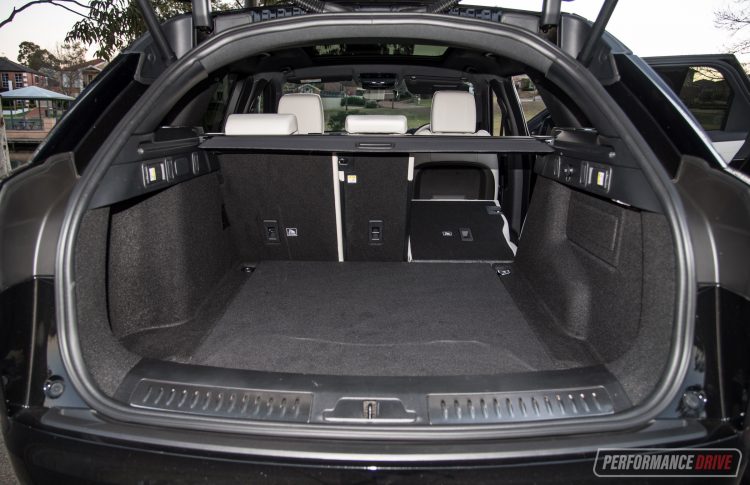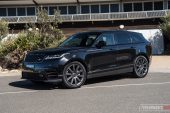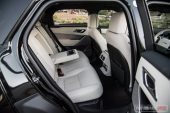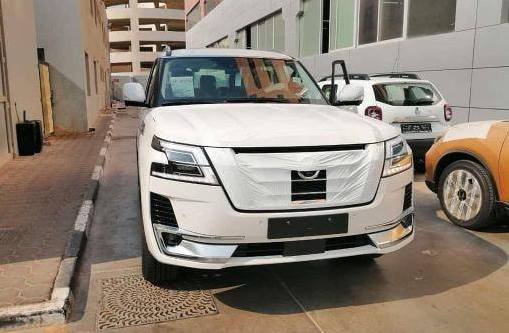Aside from featuring one of the longest names in the industry, the Range Rover Velar D300 R-Dynamic HSE oozes a level of luxury, style, and refinement that is arguably unmatched in the premium mid-size SUV market. The 700Nm twin-turbo V6 engine is also one of the beefiest, while the off-road breadth is unrivalled in this class. So, what’s not to like? Let’s see if there is anything.
This example here is pretty much the froth of the drop. It sits at the tip of the range, only surpassed by the P380 supercharged V6 petrol carrying the same remaining suffix. Well, that’s if you discount the fire-breathing P550 SVAutobiography Dynamic from SVO division, which packs a 405kW supercharged V8. Out of all variants, this D300 seems the most appealing to us as it matches the personality of the Velar perfectly. But more on that later.
Prices for this example start from a solid $126,554. That’s a big price for this segment, even getting close to the Alfa Romeo Stelvio Quadrifoglio (from $149,990), which was a world record-holder at the Nurburgring for fastest production SUV. The price also puts it in hot water when standing next to the BMW X3 M40i (from $99,900) and Mercedes-AMG GLC 43 (from $103,432). And we haven’t even started with the options yet.
2019 Range Rover Velar D300 R-Dynamic HSE – THE SPECS
[column width=”47%” padding=”6%”]Engine: 3.0-litre twin-turbo V6 diesel
Output: 221kW@4000rpm / 700Nm@1500-1750rpm
Transmission: Eight-speed auto
Drive type: All-wheel drive
Wheels: F & R: 21×8.5, 265/45
ANCAP: Five stars
Tare weight: 1954kg
Power-to-weight: 8.84:1 (kg:kW)
Official fuel economy: 6.8L/100km
Economy during test: 8.3L/100km
Fuel capacity/Type: 66L/Diesel[/column] [column width=”47%” padding=”0″]Power efficiency: 32.5kW:L/100km
0-60km/h: 3.53 seconds*
0-100km/h: 7.05 seconds*
60-110km/h: 5.03 seconds*
1/8 mile: 10.01 seconds at 119.6km/h*
1/4 mile: 15.34 seconds at 148.1km/h*
Max acceleration: 0.800g
100-0km/h braking: 3.10 seconds at 39.26 metres*
Max deceleration: -1.135g
Decibel at idle: 49*
Peak decibel at 60-100km/h: 82*
Priced from: $126,554[/column][end_columns]
* Figures as tested by PerformanceDrive on the day. Factory claims may be different
2019 Range Rover Velar D300 R-Dynamic HSE – THE PACKAGE
We won’t go over every single option available, because that could get tedious, but Land Rover does offer a wide range of personalisation and upgrade possibilities for its vehicles. This is both a good thing and a slightly overwhelming thing. It’s great because you can basically order a tailor-made vehicle, complete with your perfect colour and trim combinations, and with or without the latest technologies and gizmos. You can also customise the way it looks with various large alloy wheel designs, and implement contrasting pillars and roof colour options.
On the other hand, it is easy to become overwhelmed by the options list. And not just by the sheer amount of tick-boxes available, but the pricing of some of these. For example, this test car showcases the panoramic glass roof which is $3550 (or $4370 if you want it to open). It also features head-up display, which sets you back a rather unnecessary $2420, along with the Driver Assist pack (surround-view cameras and adaptive cruise control), which costs an extra $2223. As you can see, that initial price, which is quite high already, can be pushed much higher just by opting for stuff that should probably come standard anyway.
Surprisingly, the 18-way power-adjustable front seats are not an option on this particular variant. They are supremely comfortable, with some of the softest headrests you’ll ever see in this class. And as a bonus, the seats feature awesome massage functions, with rollers that pat and knead your back as you drive along –yes, it feels as good as it sounds. Also helping with sheer driving comfort is the adjustable air suspension, which is standard as well. It’s like driving on clouds, but we’ll talk more about that later.
The Velar interior is definitely one of the most exquisite in the class in our opinion. And we mean in terms of the design and the way everything is presented. But also the technology and the way in which it is seamlessly integrated. Take a look at the twin touch-screens on the dash. The top one pivots and adjusts to suit your height, while the bottom screen is simply a work of art. Check out the hollow twist dials that sit over the top of the screen, exposing alternating information through the middle. Graphics specialists have obviously worked wonders in this department as the drive mode menus are presented beautifully.
In terms of space and accommodation, the Velar offers generous headroom and legroom in the front, with enough pockets and drink holders to keep everyone happy. It doesn’t feel cluttered or claustrophobic, yet it does feel cosy and warm. Rear seat passengers are well catered for as well, with drink holders, climate-managing facilities, and ample legroom and headroom for this class.
Right up the back, the boot is actually one of the most capaciously capable in the class. Pop the standard electric tailgate and you’ll be presented with 558L, or 1731L with the rear seats folded. That’s more than the Audi Q5 (550L/1550L), the BMW X3 and Mercedes GLC (550L/1600L), and the Volvo XC60 (505L/unknown). Only the platform-sharing Jaguar F-Pace can top it, with some variants offering 640L/1740L, depending on the spare wheel.
2019 Range Rover Velar D300 R-Dynamic HSE – THE DRIVE
Sitting perched up in the driver’s chair, it’s a very proud and uplifting experience. You definitely get the sense this is a genuine Range Rover, just by the positioning of the straight-edged window sills on the doors and conveniently-placed armrests. There is no fold-down armrests like in the bigger Range Rovers. But even still, it’s a majestic place to sit.
Visibility isn’t the best in the class, only because most of the fixtures are quite thick and chunky. The A-pillars aren’t overly intrusive on your forward view though, but seeing over the bonnet can seem a big stretch; it’s like sitting inside a letterbox that’s made from a slab of concrete. You do get used to it pretty quick, and in return you get that commanding and ever-present power on the road.
Moseying about in town, the Velar’s air suspension is sublime. It soaks up road wrinkles and uneven ground like no other, protecting you of anything that may disturb or interrupt your otherwise pleasant journey. The steering is actually fairly quick-geared, so you don’t spend all day exhaustively wrestling with the wheel just to negotiate roundabouts and tight turns. In these senses, the Velar is perfectly at home in city and suburban environments, and thus would be a relaxing device to use to commute every day of the week.
Under the bonnet is a 3.0-litre twin-turbo V6 diesel engine. It produces a mighty 221kW at 4000rpm, and – and this is the most important part – 700Nm between 1500-1750rpm. All that torque low down in the rev range gives you an immediate understanding of what this powertrain is primarily about; effortlessness. It is so relaxing to drive, and never feels like it needs any help. No matter how steep a hill is or how full the cabin is, the Velar D300 will barge through it like a mechanical man playing rugby.
The engine is matched up to a ZF-based eight-speed automatic transmission, which distributes force into a clever all-wheel drive system. It’s not an on-demand, front-wheel-drive-based AWD system like some rivals, whereby only the front wheels are driven until slip is detected. This system delivers the torque to all four wheels, although it does adjust the front-to-rear distribution according to the demands. With all four wheels being turned there is a reassuring sense of stability and solid direction when driving at highway speeds. And double the case during wet weather.
In terms of acceleration performance, we weren’t able to achieve Range Rover’s 0-100km/h claim of 6.5 seconds. The best we could manage, according to our Racelogic Vbox Sport, was 7.05 seconds (or 7.78 seconds without building the revs on the brake pedal). This is still a very respectable time. We’ve always said that anything under 8.0 seconds can be regarded as ‘quick’. So this is more than that, particularly for a diesel SUV. One of the main encumbrances is the weight. This beast measures in at 1954kg, tare; only 10L of fuel on board. That’s the price of all of that luxury and exuberance we guess. But it’s worth it. You’re not buying an SUV like this if you want to break lap records. Leave that to the sports cars.
Obviously another element that could impede the potential acceleration is the off-road gear. Make no mistake, the Velar might look dandy and handsome, however, underneath is some proper off-road preparation and hardware. For starters you can raise the suspension up to provide a class-leading 251mm of ground clearance. The 28.89-degree approach angle and 29.5-degree departure angle will get you further than any competitor, while a water wading depth of 650mm betters anything else in the class.
And then you have the driving modes and mechanical hardware. There’s an advanced drive system which distributes the power, called Intelligent Driveline Dynamics. It incorporates a single-speed transfer case that uses a multi-plate wet clutch, as well as a chain drive for the front axle. This system is capable of redirecting up to 100 per cent of drive to the rear axle, and it can make adjustments in just 165 milliseconds.
There’s also torque vectoring and a rear differential lock available for absolutely relentless progression in serious off-road conditions. In fact, the weakest link on the R-Dynamic HSE is the standard 21-inch wheels, wrapped in sporty 265/45 tyres. Fortunately, you can option for smaller wheels that come with higher-profile tyres. If off-roading is a high priority to you, that is.
2019 Range Rover Velar D300 R-Dynamic HSE – THE VIDEO
2019 Range Rover Velar D300 R-Dynamic HSE – THE VERDICT
We love the Velar. It’s such a defining luxury SUV. It offers all the pomp and circumstance that Range Rovers are renowned for, while bringing segment-shattering levels of off-road ability, and arguable excelling in design and elegance for this class. We think the D300 is the pick of the bunch because the engine seems to suit the Range Rover mantra best; it’s relaxing and unbothered, yet hearty and strong.
[column width=”47%” padding=”6%”]PROS:
– Best interior in the class; design, materials, and technology presentation
– Supple ride thanks to standard air suspension
– Monster 700Nm of torque feels empowering
– One of the largest boots in the class
– Off-road capability stands out in the class, obviously
[/column] [column width=”47%” padding=”0″]CONS:
– Pricey options, some that should be standard
– High starting price for the D300 R-Dynamic HSE (compared with rivals)[/column][end_columns]
As always, if you’re thinking about buying a new car don’t forget to click here to speak with our car buying specialists.

































